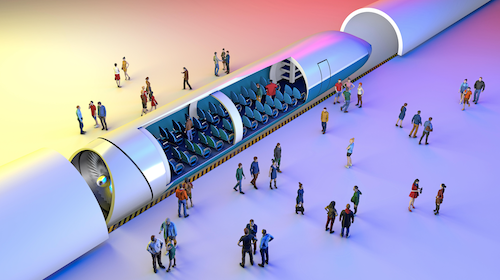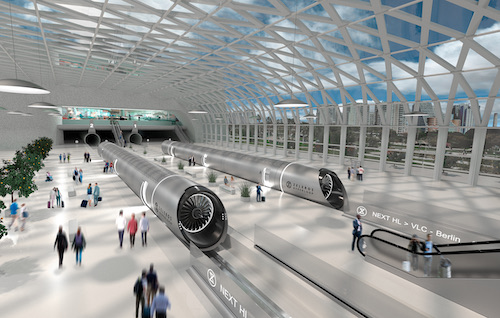Europe’s future could be one of enhanced connectivity, where passengers could get from Paris to Madrid in just 90 minutes, with almost no greenhouse gas emissions. That’s the future hyperloop technology promises: one of seamless, high-speed, climate-friendly mobility.
The concept has garnered significant attention throughout the continent in recent years and sparked debate regarding its potential, challenges and future prospects. While several European companies are already testing this technology, key issues still need to be addressed before hyperloop systems can become operational, such as its dependence on resources like lithium and rare earths that are currently sourced from China.
At its essence, the hyperloop system proposes the use of low-pressure, ‘near vacuum’ tubes to propel pods, carrying passengers or transporting cargo, at speeds of between 700 and 1,000 km/h, rivalling aeroplanes, all while consuming significantly less energy.
The pods would use a linear electric motor, similar to that of an electric car, to operate on magnetic propulsion. Simply put, they would be surfing on a magnetic wave. Further, through a ‘switch’ mechanism, the pods would be able to change lanes or arrive at multiple destinations, eliminating the need for moving components in the infrastructure. By simply pulling itself to the right or left, the vehicle can navigate different routes.
 Hyperloop technology could revolutionise mobility in Europe | Photo: Alamy
Hyperloop technology could revolutionise mobility in Europe | Photo: Alamy
Multiple companies across Europe are at the forefront of hyperloop development. The Netherlands’ Hardt Hyperloop, Spain’s Zeleros and Poland’s Nevomo are making significant advances.
To make their products ready for market, these companies have established several testing tracks across Europe. In Spain, Zeleros Hyperloop has just started testing a 20m demonstrator in the port of Sagunto, in the Valencia region, to move cargo around the port. It will eventually be scaled up to 100m. According to Juan Vicén, co-founder and vice-president of institutional relations at Zeleros, one of the key roles of the ‘hypertrack’ is to test the linear electric motor, which is 100 per cent electric and can be fully automated.
In the Netherlands, Hardt Hyperloop uses a 30m test track in the city of Delft, according to Mars Geuze, the company’s co-founder and chief commercial officer. This is allowing the company to “demonstrate the main technology”, he says. His goal is to test it out in local public transportation systems starting in 2026, to be fully operational by 2030.
The companies working on hyperloop technology have embraced a collaborative approach, focused on creating open infrastructure standards and interoperable, cross-border technologies. “No government wants to buy a monopolised infrastructure: they want one that allows them to have different suppliers and proper public procurement,” says Geuze.
In line with this collaborative mindset, the European Hyperloop Centre in Groningen, the Netherlands, is building a 30m-long open test track which includes a lane switch. It will be open to any company wishing to test its hyperloop systems. The completion of the test track is scheduled for early next year, with testing set to start by mid-2024.
The European Union has identified hyperloop technology as having the potential to help the bloc achieve its sustainability objectives outlined in the European Green Deal, and has been actively investing in its realisation through regulatory and funding initiatives.
The Commission is currently engaged in establishing regulatory framework for hyperloop systems. In its 2020 Sustainable and Smart Mobility Strategy, hyperloop was identified as a transformative mobility technology, with the EU committing to create an enabling environment for its development.
The hype around this technology is due to its compelling prospect – providing an alternative to air travel, particularly for short-distance flights. It offers comparable travel times without the associated environmental damage.
A route connecting Rotterdam and Berlin, which Hardt Hyperloop is exploring, would take around 100 minutes. There is no direct flight connection between these cities today, requiring passengers to either fly out of Amsterdam or take an eight-hour train ride.
Flights across Europe are projected to increase in frequency in the near future, with estimates suggesting a growth of 44 per cent between 2019 and 2050. In the most extreme scenario, flight numbers could surge by as much as 76 per cent. Such a surge in demand would exert significant pressure on the aviation industry and, more critically, on the environment.
Aviation has been one of the fastest-growing sources of greenhouse gas emissions since the 1990s.
According to the European Aviation's 2022 environmental report, carbon emissions from aviation in Europe are expected to triple of even quadruple if left unchecked.
The aviation industry has expressed its commitment to achieving carbon neutrality by 2050, but effecting such substantial changes within this limited timeframe is unlikely. The aviation sector will be difficult to decarbonise. Electric and hydrogen-based flights are unlikely to be a significant feature of commercial aviation by 2050.
Hyperloop technology would lead to a substantial decrease in emissions. Furthermore, the integration of solar panels, placed on the tubes, would generate energy to power the entire system. This aligns with the EU's commitment to achieve carbon neutrality by 2050, as outlined in the European Green Deal.
This technology can also be integrated within existing transportation systems. That way, “it would be less time-consuming to get the construction permits and land acquisition”, says Lucienne Krosse, a European Institute of Innovation and Technology (EIT) expert on hyperloop technology.
Anticipating the growth in passenger demand, some airports, such as Schiphol in Amsterdam, are already exploring the possibility of using hyperloop technology to replace short-distance flights. Together with Hardt Hyperloop, the airport proposes the implementation of a hyperloop network connecting it to major airports in Germany, Belgium, and France that are currently serviced by direct flights from Schiphol.
The two estimate that out of the projected 73 million passengers flying between these cities, approximately 12.5 million would opt for hyperloop travel. This transformative approach would position Schiphol as a multimodal hub, integrating both flights and hyperloop connections, ensuring its continued prominence as a vital European transportation centre.
 A computer rendition of what a Zeleros hyperloop station would look like | Photo courtesy of Zeleros
A computer rendition of what a Zeleros hyperloop station would look like | Photo courtesy of Zeleros
Still, the technology is not without its challenges. It requires substantial amounts of lithium and rare earth elements such as neodymium and samarium, for which Europe currently relies heavily on imports from China. At present, Beijing controls an estimated 80-90 per cent share of lithium refining and a 90 per cent share of global processing capacity for rare earths.
Geopolitical tensions between China and Europe or unforeseen global crises, similar to the Covid-19 pandemic, could potentially disrupt the supply chain for these vital resources.
There is a “need to have our own battery systems”, says Zeleros’s Vicén, adding that he does not perceive it as a high risk for the company. This is due to the emergence of more gigafactories in Europe. These battery-producing facilities, with a total capacity of several gigawatt hours (GWh), are on the rise. By 2030, they could help Europe achieve a 20 per cent share of global battery production, while China's share would decrease to 60-65 per cent.
Hardt’s Geuze also stresses that the hyperloop’s demand for magnets and batteries, along with the corresponding necessity for the raw materials they rely on, represents only a small fraction of the overall global demand.
For batteries, this limited demand is primarily attributed to the use of inductive charging. Hyperloop pods are equipped with relatively small batteries that can be charged at multiple points along the track through inductive charging.
Cost could present another challenge, even though current predictions seem to suggest that the costs of constructing a hyperloop track are comparable to those of building a high-speed train route. After consultations with hyperloop companies and rail entities, such as Deutsche Bahn, as well as transport companies, Krosse estimates the construction costs would be €30m per kilometre.
This is similar to the average cost of €25m per kilometre for high-speed infrastructure, as reported by the European Court of Auditors. The maintenance expenses for hyperloop are expected to be lower compared with train tracks, which are exposed to weather conditions and require more frequent upkeep. Existing train infrastructure may not be up to date, as it was built decades ago, and may require substantial investment for improvement.
However, some of the associated costs will dwindle in time, says Ethan Siegel, an American theoretical astrophysicist and science writer. While the high-speed train infrastructure is trialled and tested, he explains, hyperloop is currently incurring additional costs through both its proof-of-concept stage and in the subsequent stage of building a viable prototype. “If these companies build a hyperloop system, it will be the first of its kind,” he says. “First time you do anything is always more expensive than the twentieth time you do it.”
Developing this technology will also require a certain budget for unexpected challenges, Siegel points out, which is why it must be determined whether “the total predicted costs include margins of error for addressing mishaps”, which should be around 20 per cent of final costs, he says.
The push towards developing this new technology has some critics arguing these funds should instead be redirected towards improving already existing infrastructure.
“Solutions, like trains and [other] public transport are already available, but lack support to be more developed,” says Lorelei Limousin, a Greenpeace climate and mobility campaigner. The European Commission should focus, she says, on transforming the transport system to make it sustainable and accessible for everyone. With train alternatives under six hours already in existence for some of the busiest flight routes in Europe, Limousin says “hyperloop is just a distraction from what we should really be doing to face our current challenges”.
In response to these concerns, Vicén, of Spain’s Zeleros, says his company and others focusing on hypermobility are aiming to create an “alternative to flights for distances where there is no railway competition to aviation. For example, you never think of taking a train from Valencia to Paris. You would take a plane.” He also mentions the issue of interoperability that high-speed trains are still facing in Europe as they were built using different national standards and paradigms.
For hyperloop to be a viable alternative to trains and planes, it also ultimately has to provide a safe experience to its passengers. Travelling at such high speeds raises numerous questions concerning passenger safety that still need to be adequately addressed, including the possibility for malfunctions, system failures and hijacking.
Vicén insists that extensive research is dedicated to ensuring safety, including the provision of emergency exits every 10km. “If two pods are two and a half minutes apart, this is already enough time to make them viably depart towards different emergency exits,” he
says.
The EU has already made substantial financial investments in hyperloop technology. In 2018, the EIT allocated €5m to Hardt Hyperloop for research and development to accelerate the development of the hyperloop technology. In 2021, the Commission added another €15m. Zeleros, in partnership with other organisations across the EU, received €250,000 from the Horizon 2020 funding pool to facilitate the development of a hyperloop ecosystem, bringing together R&D institutions, industry actors, regulators and societal needs with hyperloop developers.
In the Joint Declaration of the European Parliament, the Council of the European Union and the European Commission on EU Legislative Priorities for 2023 and 2024, all three bodies specifically agree to “act on the regulatory framework for hyperloop”. Although the EU Commission initially planned to include the regulatory framework in its 2023 Work Programme, it has rescheduled it for 2024.
Sign up to The Parliament's weekly newsletter
Every Friday our editorial team goes behind the headlines to offer insight and analysis on the key stories driving the EU agenda. Subscribe for free here.